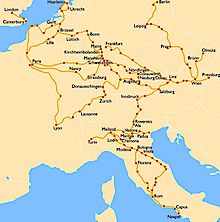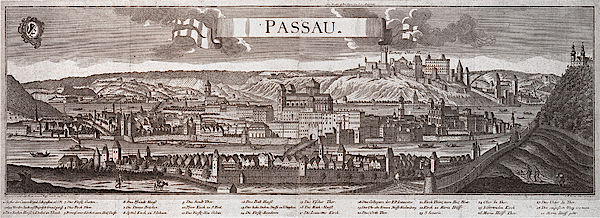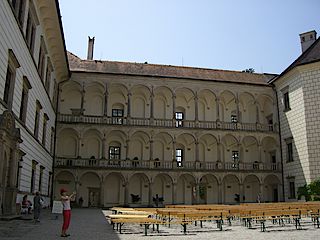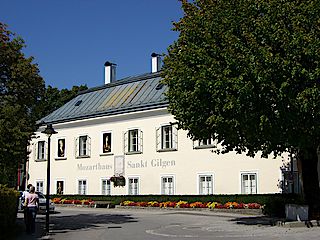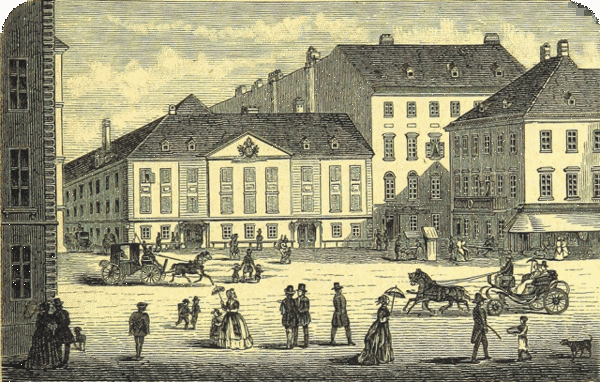Projekte
2005 Käthe Springer-Dissmann: Mozart. Post. Reisen.
Am 11. November 1762 fuhr der junge Mozart mit seiner Familie in der Postkutsche von Wien nach Pressburg, um vor dem ungarischen Adel zu konzertieren. Dabei passierte er wohl den Ort Deutsch Altenburg, der Standort einer Poststation war. Ausgehend von dieser Postreise der Familie Mozart entstand das umfassende kulturhistorische Forschungsprojekt Mozart. Post. Reisen. der Redaktion Tagbau, das verschiedene Aspekte der Mobilität, der Kommunikation und des Nachrichtenwesens im 18. und beginnenden 19. Jahrhundert untersucht. In diesem Zusammenhang erfolgten ab 2006 kontinuierlich Schwerpunktprojekte, ausgeführt von Dr. Käthe Springer-Dissmann.
Schwerpunktprojekte des Projekts Mozart. Post. Reisen.
2022 Archduchess Leopoldine of Austria, first Empress of Brazil (1797-1826). Her childhood and youth at the Court of Vienna
2021 Anna Maria Mozart, Reisende. Die Reisetätigkeit der Mozartin
2020 Reiseziel München – Mozart in Bayern
2016 Die Mozartin – Anmerkungen zu Anna Maria Walburga Mozart, geb. Pertl (1720-1778)
2011 An der Schwelle. Vortrag anlässlich der Eröffnung der neuen Räumlichkeiten des Don Juan Archivs Wien in der Trautsongasse 6, 1080 Wien, gehalten am 16. Dezember 2011.
2011 Gluck the Wanderer. Travels of a European composer
2011 Gluck Crossing the Paths of Don Juan. Routes of two great European wanderers
2008 Mozart goes to Constantinople! The real conditions of a fictitious journey
Projekte 2005-2006
Schwerpunktprojekte im Detail
2022 Archduchess Leopoldine of Austria, first Empress of Brazil (1797-1826). Her childhood and youth at the Court of Vienna
On September 7, 2022 Brazil celebrated 200 years of its independence – a fitting occasion to recall the role of Archduchess Leopoldine of Austria, who by the side of her husband Dom Pedro de Alcântara became involved in the stormy process which led to Brazil’s separation from Portugal and made her as Dona Leopoldina the first Empress of the newly independent country. Yet, it is almost impossible to understand Leopoldine’s willingness and ability to take on her historical role in Brazil without knowing the background of the Vienna-born Habsburg princess. This study therefore focuses on Leopoldine’s origins, the principles of her upbringing as a Habsburg daughter, and the divergent influences on her personal development – crucial factors that enabled her to move on from her destiny of being merely a game ball of the Habsburg marriage policy to becoming a political player herself. Another topic in this context is the huge expedition of natural scientists and artists that accompanied the archduchess, who was an accomplished expert in this field herself, to Brazil. The group was to travel in the vast country, which at that time was nearly unknown in Europe. Their abundant collections resulted in the opening of the unique „Brasilianum“, a special Museum in Vienna, which existed from 1822 to 1835 and during that period made the Habsburg capital a leading center of Brazil research in Europe.
This extensive research project was presented for the first time in September 2022 in Vienna at the International Don-Juan-Days, organized by the Don Juan Archive Vienna et al. from 29 Septmeber to 1 October 2022 in memory of the first Don Giovanni performance in Brazil on 20 September 1821.
2021 Anna Maria Mozart, Reisende. Die Reisetätigkeit der Mozartin
Die Reisetätigkeit der Familie Mozart wird in dieser Arbeit nicht wie meist üblich aus dem Blickwinkel von Vater und Sohn Mozart betrachtet, sondern richtet den Fokus auf die Reisende Anna Maria Mozart. Zwar sind ihre Reisebriefe – mit Ausnahme ihrer Paris-Reise 1777/1778 – nicht erhalten. Dennoch lässt sich aus den Briefen Leopold Mozarts und der späteren Korrespondenz zwischen den Eheleuten die aktive, humorvolle und interessierte Teilnahme seiner Frau ersehen. Wie ihre Familie, so geht daraus hervor, schätzte auch Frau Mozart das Reisen – trotz aller Strapazen und Mühen, die das Unterwegssein zu jener Zeit bedeutete. Auch teilte sie mit ihrem Mann offensichtlich die Auffassung jener Zeit, dass Reisen nicht nur pragmatische Notwendigkeit war, sondern stets auch der Bildung und Persönlichkeitsentwicklung zu dienen hatte. In diesem Zusammenhang erhellt ein Exkurs über das emanzipatorische Reiseverständnis, die technischen Reisemöglichkeiten und die Reisekultur in der Epoche der Aufklärung den historischen Kontext, der die Reisetätigkeit der Mozarts bestimmte.
Der Vortrag wurde von Dr.in Käthe Springer-Dissmann bei dem Zoom-Symposium zum 300. Geburtstag von Anna Maria Mozart, geb. Pertl (1720-1778), gehalten und im Sammelband des Symposiums „mater celebrr. Mozart“, hgg. von Anja Morgenstern und Eva Neumayr, 2023 im Hollitzer Wissenschaftsverlag publiziert.
2020 Reiseziel München – Mozart in Bayern
Von Kindheit an führten Reisen Wolfgang Amadé Mozart von Salzburg nach oder über München. Die erste davon – es war die erste Reise der Familie Mozart überhaupt – erfolgte im Winter 1762, doch sind die Hinweise darauf besonders spärlich. Dennoch, aus zeitgenössischen Karten, Reiseberichten und späteren Briefen von Leopold und Wolfgang Mozart lassen sich problemlos die Routen, Reisebedingungen und möglichen Landschaftseindrücke dieser und späterer Fahrten der Mozarts durch Bayern erschließen. (Unpubl.)
2016 Die Mozartin – Anmerkungen zu Anna Maria Walburga Mozart, geb. Pertl (1720–1778)
Anhand der zahlreichen Briefquellen der Familie Mozart wird in dieser Studie die Rolle und Persönlichkeit der Mozartin, wie sie zu Lebzeiten genannt wurde, vielseitig dargestellt. Die Geschichte ihrer Vorfahren und ihre eigene Geschichte, beginnend in St. Gilgen am Wolfgangsee (Salzburg), wird dokumentiert, ebenso ihr turbulentes, von Humor, Respekt und herzlicher Zuneigung, ja beinahe partnerschaftlichem Verständnis getragenes Ehe- und Familienleben, Frau Mozarts Geselligkeit, ihre Reiselust, ihr Musikverständnis und ihr Interesse an Kunst und Kultur. Anna Maria Walburga Mozart starb – am Ende vereinsamt, verarmt und schwer erkrankt – am 3. Juli 1778 in Paris. Ihr Weg, der sie von St. Gilgen in die Stadt Salzburg und von dort mit ihrer musikalischen Familie zu ausgedehnten Reisen durch Europa geführt hatte, wird in dieser Studie nachgezeichnet, mit dem Ziel, die von der Nachwelt zumeist unterschätzte und marginalisierte Persönlichkeit von Frau Mozart zu würdigen und neu zu bewerten.
Die Ergebnisse dieser Arbeit wurden am 15. Oktober 2016 von Dr.in Käthe Springer-Dissmann im Rahmen des Symposiums „Maria Anna Mozart im Kontext ihrer Familie“, veranstaltet von der Universität und der Stiftung Mozarteum sowie der Maria Anna Mozart Gesellschaft Salzburg, in Salzburg vorgetragen und in dem Band Maria Anna Mozart. Facetten einer Künstlerin, hg. von Eva Neumayr, Wien: Hollitzer Verlag 2019, publiziert.
2016 Joseph Maria Count Thun-Hohenstein: Princebishop of Passau and initiator of Joseph Friebert’s career as Hofkapellmeister in Passau
Joseph Maria Count Thun-Hohenstein (1713-1763), the powerful princebishop of Passau, played a crucial role in the life and work of Joseph Friebert (1725-1799) as his employer in 1763. Though Thun’s reign was quite short, he initiated Friebert’s work as an influential musical director and composer in the Bavarian city of Passau, a position Friebert was to hold for more than three decades.
In 1762, one year before Friebert’s appointment, Leopold Mozart stopped in Passau with his family while on their first journey to Vienna. After a five-day wait, an impatient Leopold finally succeeded in having his son play a concert at the archiepiscopal court. The picture of the archbishop Mr Mozart gives in his travel letters is not too flattering – and has since maybe not enough been scrutinised.
Several topics are up to debate: Who was Joseph Maria Count Thun-Hohenstein, aside from Leopold Mozart’s rather negative impressions? What role did he, the princebishop of one of the most important dioceses of the Holy Roman Empire and a distinguished reformer of enlightened Absolutism, play in the ecclesiastic, cultural and economic life of Passau? After all, it was Thun’s reform spirit that led him to revive the court orchestra and fill a position that had been vacant for two decades: the Hofkapellmeister. To that position he appointed Joseph Friebert, in whose era Passau was to become the setting for the earliest and most intensive cultivation of the musical dramas of W. A. Mozart.
This project was presented in 2016 in Salzburg at the International Interdisciplinary Symposium „Das Serail by Joseph Friebert (1778) in historical, socio-political and cultural context(s)“, organized by the Don Juan Archiv Wien, the University Mozarteum Salzburg/ Mozart Opera Studies Institute, and the Salzburg Global Seminar (May 19-21, 2016). Presumable publication date: 2017.
2011 An der Schwelle. Vortrag anlässlich der Eröffnung der neuen Räumlichkeiten des Don Juan Archivs Wien in der Trautsongasse 6, 1080 Wien, gehalten am 16. Dezember 2011
Der Vortrag wirft einen Blick in die Vorgeschichte des Don Juan Archivs Wien, und er enthält einen kultur- und theaterhistorischen Streifzug durch die neue Umgebung des Instituts. Der vollständige Text findet sich hier.
2011 Gluck the Wanderer. Travels of a European composer
At the dawning of the age of modern transport systems, when the mobility of artists was at least no less international than it is today, Christoph Willibald Gluck (1714-1787) was a travelling composer par excellence. Like Mozart (even more so) he spent most of his life on the road from childhood on and even after finally settling down the second time in Vienna at the age of 65, he still planned further journeys, though he was by then too weak to carry them out.
This project presents Gluck’s life and career as determined by his restless tours through Europe in the pre-revolutionary era of the Enlightenment – from Bohemia to Italy; from London to Hamburg, Dresden, Copenhagen, Prague, and Naples; and several times between Vienna to Paris – and point out how the composer’s vagabond existence shaped his ideas and rightly earned him the reputation of being a cosmopolitan artist.
With Gluck’s music for the reformist ballet pantomime Don Juan ou Le festin de pierre in mind – choreographed by Gasparo Angiolini and staged in Vienna in 1761 – the study explores the composer’s itinerary as it criss-crosses the paths of the stage figure Don Juan, whose story was spread out across Europe during the seventeenth and eighteenth centuries mainly by touring companies.
Gluck himself was – with interruptions – a member of various travelling opera troupes between 1746 and 1752. He worked first with the brothers Pietro and Angelo Mingotti and then with Giovanni Battista Locatelli, who belonged to the artistically most significant Italian touring opera companies of the time.
Many stages of Gluck’s life persist in the dark of anonymity, among them tantalisingly his years with itinerating opera troupes, which are primarily documented by the dates of his premieres and a few records by contemporaries. Nonetheless, this period – that corresponds so strongly with Gluck’s prevailing call for freedom – marks a milestone on his rise to becoming the outstanding European phenomenon that is sketched out in the conclusion of this study.
The project was presented in 2011 in Istanbul at the International Symposium „Ottoman Empire & European Theatre. IV. The Turkish Subject in Ballet and Dance from the Sixteenth Century Onwards. A Commemoration of the 250th Anniversary of Don Juan ou Le Festin de Pierre (1761) by Gasparo Angiolini (1731-1803) and Christoph W. Gluck (1714-1787) in Vienna“. Organized by the Don Juan Archiv Wien, in cooperation with the UNESCO International Theatre Institute in Vienna and the Austrian Cultural Forum in Istanbul (April 29-30, 2011 in Vienna and June 9-10, 2011 in Istanbul) and published in 2016.
2011 Gluck Crossing the Paths of Don Juan. Routes of two great European wanderers
During my research on Christoph Willibald Gluck (1714-1787) as a 18th century traveller par excellence, I realized that his itineraries coincided with the theatrical journeying of Don Juan, the legendary stage figure and eponymous hero of the composer’s innovative ballet music Don Juan, staged in Vienna in 1761.
This gave me the idea of linking the composer’s itinerant biography with places crucial for the spreading of the Don Juan theme – a “wandering” myth of the European theatre, made popular by the travelling theatre and opera troupes of the 17th and 18th century, of which Gluck himself was a member. Gluck’s “vagabond existence”, his disregard for national boundaries, political or cultural, corresponded with his wholehearted appreciation of liberty and furthered the cosmopolitan attitude that is reflected in his innovative musical concepts.
This project is an exploration of the criss-crossing routes of the two European “wanderers”, Don Juan and his reformist composer, who – by his own credo (1774) – wanted to “produce a music fit for all nations and to do away with the ridiculous differentiation between national musical styles”.
This study was presented in London at the „Don Juan Day“ of the Open University Literature and Music Resarch Group on September 23, 2011.
2010 ,Now at length we’re off for Turkey, Lord knows when we shall come back!’ Byron’s Grand Tour to the Bosporus 1809-1811
On July 2, 1809, George Gordon Lord Byron (1788-1824) set out on one of the last grand tours of the nineteenth century. Accompanied by his friend John Cam Hobhouse (1786-1869), the poet travelled from London to Constantinople via Portugal, Spain, Gibraltar, Malta, Albania, and Greece where in 1810 he crossed the Hellespont, swimming like the mythic Leander from Sestos to Abydos. The crossing brings to mind a “rite de passage” (‘rite of passage’; Arnold van Gennep, 1873-1954), a departure to new spiritual horizons, just as Childe Harold was expecting from his Pilgrimage. The poem’s first two cantos are the record of Byron’s own pilgrimage to the East that indeed served its purpose; it marked a decisive turn in Byron’s life, opened a new world of thinking and feeling, and made him a poet: Cantos I and II of Childe Harold, drafted on the road, were published in London in 1812 with sensational success and established Byron’s literary fame. The ‘clime of the East’ had affected him.
This project unfolds Byron’s fateful Oriental journey - and literary pilgrimage - in three acts. A prologue discusses how travel ideas changed from the era of Enlightenment to the Romantic epoch in the aftermath of the French Revolution and the Napoleonic wars. After that we follow Byron from London to the southern Balkans (Act 1). Special emphasis is laid on Byron’s visit to Albania, a wild, remote and unusual destination, that left its marks in Childe Harold’s Pilgrimage as well as in Don Juan. Byron was a guest at the Seraglio of the Ottoman vizier Ali Pasha (1741-1822) (Act 2) in Tepelene, flattered and fascinated by the tyrant’s exotic court and wicked power. After a month in Albania he continued on his tour via Greece to Constantinople (Act 3). In the epilogue we’ll refer to his journey back to London, where he arrived again in July 1811, after two years of travels in the eastern Mediterranean, a lover henceforth of freedom and Greek independence – where his destiny would ultimately lie: he died in Missolonghi, Greece, a romantic hero of liberty in a war instigated, in fact, by his Albanian protector Ali Pasha.
The study was presented in 2010 in Vienna at the International Symposium „Ottoman Empire and European Theatre. III. Seraglios and Harems in Theatre, Opera, and Poetry from the Early Seventeenth Century to Lord Byron’s Don Juan (1819-1824). A Commemoration of the Bicentenary of Lord Byron’s Sojourn in the Ottoman Capital (1810)“, organized by the Don Juan Archiv Wien in cooperation with the UNESCO International Theatre Institute in Vienna and the Austrian Cultural Forum in Istanbul (April 23-24, 2010 in Vienna and May 27-28, 2010 in Istanbul) and was published in 2015.
2009 Mozart im Süden Böhmens. Die Poststraße Wien-Prag und die Region Neuhaus. Eine musikalische Rundreise
Mozarts Reisen in die Böhmischen Länder (Erste Prag-Reise Jan./Feb. 1787, zweite Prag-Reise Okt. 1787, Reise von Wien über Prag nach Berlin und retour 1789 sowie dritte Prag-Reise 1791) sind Ausgangspunkt einer Untersuchung der damaligen Postroutenverbindungen zwischen Wien und Prag. Weitere Themen dieses Projekts sind das Musikleben Böhmens im 18. Jahrhunderts sowie Schlösser und Orte Südböhmens, die mit der Theater- und Musikgeschichte jener Region in Zusammenhang stehen.
2009 Did Mozart drive a ,Haydn’? Cartwrights, carriages and the postal-system in the Austrian-Hungarian border area up to the Eighteenth century
In the course of their first trip to Vienna (Sept. 18, 1762 – Jan. 5, 1763) the Mozarts went by mailcoach to Pressburg, at that time the capital of Hungary, where Wolfgang and his sister Nannerl played for the Hungarian aristocracy (Dec. 11-24, 1762). There Leopold decided to buy a carriage for a safe journey back to Vienna and from there home to Salzburg. Half a year later the Mozarts used it for their grand tour of western Europe (1763-1766).
This carriage may in fact be an indirect link between Mozart and Haydn. Living in the border area next to the Kingdom of Hungary, the Haydns had worked successfully as cartwrights for two generations, until the sons Joseph, Michael und Johann left the family business and dedicated themselves to music. It is likely that many carriages used in the eastern corner of Lower Austria and across the Hungarian border, including Pressburg, came from the workshops of this wide spread family (only in 1758 did a law enacted by Maria Theresia forbid the profession of cartwright to be the exclusive domain of certain craft families). So the first carriage the Mozarts owned may well have been a “Haydn”.
Starting from this Haydn family background the study outlines a short history of the use of carriages, a history that coincidentally had its roots in this region, in the western Hungarian village of Kócs from where the term coach (Germ. Kutsche, Span. coche, Ital. cocchio etc.) presumably derives. They were first mentioned in 1487. Three years later, in 1490, the postal system was established in the Holy Roman Empire, creating the conditions for the regular coach und postal traffic in the eighteenth century. It made Mozart’s Europe-wide journeys possible, and it also facilitated Joseph Haydn’s travels and correspondence. It is with reference to the latter during Haydn’s long service to the Hungarian princes of Eszterházy that this work considers also the development of the Hungarian postal system, a development that took place under the impact of the wars between the Habsburg and Ottoman Empires. It shows, too, the mail and travel connections between Vienna, Eisenstadt, Eszterhàz and Pressburg as the main destinations in Haydn’s Hungarian period.
This study was presented in Vienna at the international Symposium „Ottoman Empire & European Theatre. II. The Time of Joseph Haydn (1732-1809): From Sultan Mahmud I to Mahmud II (r. 1730-1839)“, organized by the Don Juan Archiv Wien in cooperation with the UNESCO International Theatre Institute in Vienna and the Austrian Cultural Forum in Istanbul, (April 24-25, 2008 in Vienna and June 4-5, 2008 in Istanbul), the work was published in 2014.
2008 Mozart goes to Constantinople! The real conditions of a fictitious journey
The idea of Mozart’s fictitious journey to Constantinople gives us the opportunity to demonstrate how people travelled during Mozart’s lifetime in the second half of the eighteenth century, and to consider the requirements and conditions of such a journey, the type of infrastructure that existed, the modes of transportation and routes that were taken, etc. The study comments on how this period fits into the history of travel, and gives a sense of Mozart as a traveller. But first and foremost, it will describe the possible journey made by the composer into the Ottoman Empire: for him, an artistic experiment to put to the test the ‘Oriental’ fantasies that were popular on European stages in the eighteenth century. These fantasies themselves were analysed during the course of the International Symposium „Ottoman Empire and European Theatre. I. From the Beginnings to 1800. Sultan III Selim & Mozart“, organized by the Don Juan Archiv Wien in cooperation with the UNESCO International Theatre Institute in Vienna and the Austrian Cultural Forum in Istanbul, (April 25-26, 2008 in Vienna and June 5-6, in Istanbul), where this study was presented. For some of the conference participants both of the symposium’s relevant locations were connected by real travel; for others, their journeys were imaginary expeditions like Mozart’s. But for all of us it was a pleasant journey with new scholarly insights as we departed into the unknown.
The study was published in 2013.
Projekte 2005-2006
2006 Käthe Springer-Dissmann: „Freylich ists in St. Gilgen nicht lustig ...“ Auf den Spuren der Familie Mozart im Salzkammergut
St. Gilgen (Salzburg) ist sowohl Herkunftsort von Mozarts Mutter Anna Maria Walpurga (geb. Pertl, 1720-1778) als auch späterer Wohnort ihrer Tochter Anna Maria Walpurga Ignatia („Nannerl“, 1751-1829), die hier als Ehefrau des Pflegers Johann Baptist Franz von Bechtold zu Sonnenburg von 1784 bis zum Tod ihres Gatten im Jahr 1801 lebte. Die Geschichte dieser beiden Mozart-Frauen, die mit St. Gilgen in so enger Verbindung steht, wie auch die postalischen Wege der weiterhin regen Verbindung zwischen „Nannerl“ im Salzkammergut und ihrem Vater Leopold in Salzburg werden in dieser Arbeit dargestellt.
2005 Käthe Springer-Dissmann: Das Theater in der Leopoldstadt / Das Carltheater
Das Leopoldstädter Theater wurde am 20. Oktober 1781 in der Jägerzeile (heute Praterstraße 31) unter Karl Marinelli eröffnet. Es war die „erste stehende Volksbühne“, die durch die Erfolge Johann La Roches als „Kaschperltheater“ berühmt werden sollte.
1791 erwähnt Mozart dezidiert einen Besuch im „Kasperltheater“ in der Leopoldstadt: „ich gieng dann um mich aufzuheitern zum Kasperl in die neue Oper der Fagottist [Singspiel Kaspar, der Fagottist Oder die Zauberzither, Text: Joachim Perinet, Musik: Wenzel Müller], die so viel Lärm macht – aber gar nichts daran ist.“ (W.A. Mozart, 12.6.1791, MBA, Bd. IV, Nr. 1161, Z. 10-22.) Es steht jedoch zu vermuten, dass Mozart die äußerst populäre Bühne schon davor besucht hat.
Dies ist unter anderem Gegenstand der Studie, die sich mit der Geschichte der beiden Wiener Vorstadtbühnen Theater in der Leopoldstadt (1781-1847) und Carltheater (1847-1929) und ihrer Bedeutung als Aufführungsorte des Alt-Wiener Volkstheaters beschäftigt.

